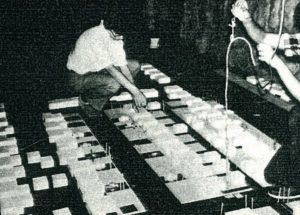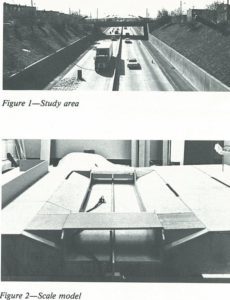Scale Modeling for Shut-ins
04.01.2010 | HMMH |by Doug Barrett
Not so long ago (OK, I’m talking about the 1970s and 1980s, maybe that was a long time ago!) acousticians sometimes had to build real 3-D models. Computer models today can account for shielding provided by terrain and structures, reflections off of and diffraction over and around obstacles, and acoustical impedance of different ground types. But just a couple of decades ago, these calculations were beyond the reach of the best computer models, and acousticians sometimes resorted to constructing actual scale models. These scale models would include buildings and other objects all constructed to scale, much like an architect’s model, but also would include microphones at the receiver locations and artificial noise sources.
Building a scale model of a house or a street is one thing, but acousticians also had to deal with creating properly-scaled sound waves. For example, one may have been interested in modeling 500-Hz traffic noise which, in the real world, has a wavelength of about two feet. However, in a 1:24 scale model (one inch = two feet), one had to use an artificial noise source with a wavelength of about one inch to model 500-Hz sound. To have a one-inch wavelength, the artificial noise source would need to generate a frequency of about 12,000 Hz.
Now stick with me, because I promise this all ties-in, but a few weeks ago, I came down with pneumonia and spent a lot of time flat on my back. One day, while recuperating, I was resting on my living room couch. Every now and then I would cough, and each time – almost exactly concurrent with my cough – I heard a faint ringing sound, not unlike a gong sounding in a distant room. At first I attributed this either to my fever or too much cough medicine, but upon reflection, another explanation occurred to me.
To digress for a moment, individuals living close to airports, particularly in locations alongside a runway or behind the start-of-takeoff roll for departing aircraft, sometimes complain of rattling windows or other loose objects, such as pictures on walls or light objects on shelves. The rattling is caused when low-frequency noise (LFN) generated by departing jet aircraft excites, or shakes, the homes. Sometimes the LFN may be difficult to hear directly (our ears do not hear LFN as well as they do higher frequencies), but the wavelengths may be about the same length as major elements of a house. For example, at 50 Hz, the wavelength is approximately 20 feet. When this occurs, LFN can cause elements of the house to resonate, or vibrate, at that particular frequency. This, in turn, causes windows and other loose objects to rattle.
Getting back to my coughs and the mystery ringing noise — we happen to have a vaguely Calderesque mobile hanging in our living room directly above the couch where I was resting. The entire mobile spans a few feet and consists of nylon fabric panels stretched across wire frames. The largest panels, which are about six to eight inches across, would resonate at roughly 1,500 to 2,000 Hz. One possible explanation is that this also was the frequency range of my coughing. Now imagine that these six- to eight-inch panels represent walls of a 12- to 16-foot wide room built for a 1:24 scale model study. Keeping with the 1:24 scaling comparison, my coughs would scale down to about 60 to 80 Hz, not unlike LFN generated by a jet aircraft. So maybe it wasn’t too much cough medicine after all. Perhaps my coughing had created a low-budget scale model for LFN rattle effects!








